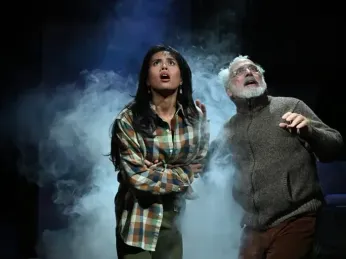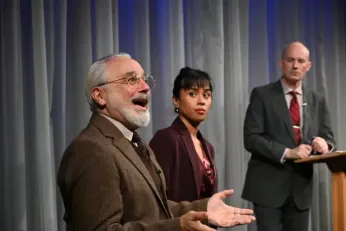
Sep 29
An extra twist enhances Shotgun Players’ ‘The Motion’
Jim Gladstone READ TIME: 1 MIN.
The September 26 performance of ‘The Motion,’ San Francisco playwright Christopher Chen’s provocative mind game drama, at Shotgun Players’ Ashby Stage in Berkeley, was one of the most thrilling evenings I’ve ever spent in a theater.
The production continues through Oct. 12. Your experience, inevitably, will vary. One of theater’s essential attributes is its aliveness. No matter how tightly a script is written, the best performances are never rote. Actors will tell you that, even playing a role as many as eight times each week, every performance is different.
Over the run of a show, they continue to excavate deeper nuance in their characters; palpable feedback loops connect a cast to each audience; an understudy steps in and subtly alters the ensemble chemistry.
Less subtle variations also occur: Patti LuPone breaks character to scold a spectator. Actor Joseph Greenwald, playing the lead role in Clifford Odets’ “Golden Boy” speaks the line, “I waited for this moment all my life,” then promptly drops dead on stage. During the performance of “The Motion” I attended, actor David Sinaiko had a nosebleed. Hold that thought.
Four shadowing
Siniako plays Dr. Alan James, one of four articulate, well-educated authorities gathered for a public intellectual debate. Theatergoers are cast as debate attendees: On entering the auditorium, they see stage techs and performers (in character) conducting sound checks, adjusting chairs, straightening ties, and smoothing hair as if preparing for a program at the Commonwealth Club.
The proceedings begin, a pontificant moderator (Erin Gould, amusingly starchy) asking the crowd to place advance Yes/No votes on the motion to be debated: “Ban animal testing now.” A clicker-wielding assistant counts raised hands and shares the results.
Dr. James and Professor Lily Chan (Gabrielle Maalihan), champion the absolutist anti-testing argument, seem outmatched by the boilingly self-righteous Dr. Matthis (Erin Mei-Ling) and smooth self-amused Professor Neel Serrano (Soren Santos).
Playwright Chen arms the members of this foursome with provocative aperçus such as “Animals pay our unhealthy lifestyle bills,” in regard to research conducted in pharmaceutical development; and “sentience is elusive,” regarding the degree to which animals think and feel relative to humans.
That latter notion will become particularly relevant in the play’s closing scene, which raises disturbing parallels between our historic relationship with animals and our future relationship with AI.
The debate is derailed when the characters find themselves sporadically able to read each other’s minds, then make modifications in formerly intractable opinions. One relatable, laugh-out-loud exchange concerns a vegetarian’s deeply repressed craving for cheeseburgers.
Dramaturgical derring-do
Clairvoyance is just the springboard of Chen’s ballsy leap into genre-blending. “The Motion” gleefully Vitamixes social drama, comedy, science fiction, and horror. And it’s an immersion blender, pulling the audience into its whirlpool of seemingly contradictory elements as it mashes and macerates them into one spooky smoothie.
Director Patrick Dooley is also all-in, handling unruly material with unwavering confidence. His poker-faced production never winks at the audience or calls boastful attention to its deeply embedded ironies.
As they question their partial mind meld, the Docs and Profs are abruptly addressed by a deep, electronically distorted off-stage voice belonging to some higher power. And they’re subsumed into a thrumming forcefield (In the show’s weakest moment, they do Marcel-Marceau-invisible-box schtick to acknowledge their entrapment).
The production then takes an even sharper left turn with a blackout, then a frightening explosion of light and clamor (Christian V. Mejia designed the bold lighting; Matt Stines, the impressively complex, layered soundscape). It’s a paradigm-shifting moment for characters and audience alike.
The moderator and debate set whisked away, our brainy quartet finds itself in a sleek split-level home fully stocked with plenty of wine and other bourgeois necessities. But their memories of the past are becoming fuzzy and there seems to be no way out. It’s a midcentury modern mindfuck. (The house, its stylish but anodyne interior design, and the sudden transition that brings us there is the award-worthy work of scenic designer Nina Ball).

Domestic dilemma
Characters and audience alike quickly realized that this house is a human-scale Habitrail. The protagonists are lab rats in an experiment, the theatergoers among those studying them. True to their intellectual bent, the surrogate rodents begin to ponder some fascinating questions as they adapt to the leisure-class luxury of their new situation.
Sure, they were placed here by force and without consent, but day-to-day circumstances are actually easy and enjoyable. Professors Chan and Serrano have fallen in love. They can’t imagine separating and returning to their prior “real world” relationships. Have they entered a tender trap, or a brave new way of living? Their unknown overseers could change everything again in a moment, so can they ever truly relax and have a sense of stability?
Three years later, passive consensus will find them sipping wine and pondering in place.
Then, Dr. James has that nosebleed. As Professor Chan tends to him, they walk off to another part of the house. Probably the bathroom to get some tissue.
And then the stage blacks out again.
Moments later, an amplified offstage voice announces that there’s been a medical emergency and that in a few minutes she’ll let us know if the show can continue.

House arrest
As the house lights went up, the audience began to chatter. Some shook their heads in delighted disbelief (or, technically, in refusal to release previously suspended disbelief), They turned to neighbors in their rows, expressing certainty that this was likely another scripted surprise in an evening full of them.
Friendly debate ensued: “No way!”; “Hundred percent!”; “They wouldn’t do that would they?”.
The Berkeley High junior in front of me with her father, asked what I thought.
“It seems like part of the show,” I supposed. “It started with audience participation, there have already been wild shifts, and its about experiments being performed on people.”
As we continued to chat, moving on to her school’s homecoming celebration the next day, and the potential value of a pre-college gap year. I felt extremely engaged with my new accquaintance and with the deliriously meta play we were, perhaps, in the midst of.
Well past the five-minute mark, no further announcement had been made. Some spectators left their seats, most wandering out to the lobby, a few leaving for home.
Those who stayed behind continued to shepherd evidence that this was all misdirection:
“Just before the lights went out, the characters were debating whether they’d rather stay where they are, or go home”; “They’re selling drinks in the lobby; who would do that in a medical emergency?”
“When we came in, the lady handing out programs said the show was two hours, with no intermission. But then the announcement at the beginning of the ‘debate’ said it would be about 90 minutes.”
Radical shift
In about 15 minutes, the length of a typical intermission, an announcement was made that the show would resume momentarily.
And so it did, with another radical shift in setting along with the return of Erin Gould, who’d played the moderator. He wore casual clothes now instead of a tidy suit, but looked fundamentally the same.
He confirmed the others’ assumption that they were the subjects of an experiment, going on to say that he couldn’t share any further details. Because he was a robot.
Chen’s blissfully tortuous plot then took its final turn. Without revealing too much detail: Some of the main characters were forced to consider the morality of destroying the nearly-human robot on behalf of a greater good.
As far as I was concerned, Chen’s script and this world premiere production of “The Motion” were already unqualifiedly good, verging on great. But I can’t deliver an assessment on where it falls within that scale, because after the final curtain, still feeling uncertain, I asked a Shotgun staff member, who let me know that David Sinaiko had indeed suffered a nosebleed.
All I can say is that at the performance I saw, the indecipherable blur of art and reality, the transformation of an audience into an invested community, and the cross-linked imaginations of theatermakers and spectators made “The Motion” profoundly moving.
‘The Motion’ through Oct. 12. $23-$80. Ashby Stage, 1901 Ashby Ave., Berkeley. http://www.shotgunplayers.org



